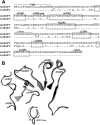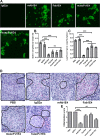Characterization of a lipopolysaccharide-targeted monoclonal antibody and its variable fragments as candidates for prophylaxis against the obligate intracellular bacterial pathogen Coxiella burnetii
- PMID: 25114119
- PMCID: PMC4249325
- DOI: 10.1128/IAI.01695-14
Characterization of a lipopolysaccharide-targeted monoclonal antibody and its variable fragments as candidates for prophylaxis against the obligate intracellular bacterial pathogen Coxiella burnetii
Abstract
Our previous study demonstrated that treatment of Coxiella burnetii with the phase I lipopolysaccharide (PI-LPS)-targeted monoclonal antibody (MAb) 1E4 significantly inhibited C. burnetii infection in mice, suggesting that 1E4 is a protective MAb. To determine whether passive transfer of antibodies (Abs) can provide protection against C. burnetii natural infection, we examined if passive transfer of 1E4 would protect SCID mice against C. burnetii aerosol infection. The results indicated that 1E4 conferred significant protection against aerosolized C. burnetii, suggesting that 1E4 may be useful for preventing C. burnetii natural infection. To further understand the mechanisms of 1E4-mediated protection and to test the possibility of using humanized 1E4 to prevent C. burnetii infection, we examined whether the Fab fragment of 1E4 (Fab1E4), a recombinant murine single-chain variable fragment (muscFv1E4), and a humanized single-chain variable fragment (huscFv1E4) retained the ability of 1E4 to inhibit C. burnetii infection. The results indicated that Fab1E4, muscFv1E4, and huscFv1E4 were able to inhibit C. burnetii infection in mice but that their ability to inhibit C. burnetii infection was lower than that of 1E4. In addition, treatment of C. burnetii with Fab1E4, muscFv1E4, or huscFv1E4 can block C. burnetii infection of macrophages. Interestingly, treatment of C. burnetii with huscFv1E4 can significantly reduce C. burnetii infectivity in human macrophages. This report provides the first evidence to demonstrate that the humanized variable fragments of an LPS-specific MAb can neutralize C. burnetii infection and appears to be a promising step toward the potential use of a humanized MAb as emergency prophylaxis against C. burnetii exposure.
Copyright © 2014, American Society for Microbiology. All Rights Reserved.
Figures







Similar articles
-
Development of a lipopolysaccharide-targeted peptide mimic vaccine against Q fever.J Immunol. 2012 Nov 15;189(10):4909-20. doi: 10.4049/jimmunol.1201622. Epub 2012 Oct 10. J Immunol. 2012. PMID: 23053512 Free PMC article.
-
Mechanisms of vaccine-induced protective immunity against Coxiella burnetii infection in BALB/c mice.J Immunol. 2007 Dec 15;179(12):8372-80. doi: 10.4049/jimmunol.179.12.8372. J Immunol. 2007. PMID: 18056383
-
Coxiella burnetii interaction with neutrophils and macrophages in vitro and in SCID mice following aerosol infection.Infect Immun. 2013 Dec;81(12):4604-14. doi: 10.1128/IAI.00973-13. Epub 2013 Sep 30. Infect Immun. 2013. PMID: 24082077 Free PMC article.
-
Q fever: persistence of antigenic non-viable cell residues of Coxiella burnetii in the host--implications for post Q fever infection fatigue syndrome and other chronic sequelae.QJM. 2009 Oct;102(10):673-84. doi: 10.1093/qjmed/hcp077. Epub 2009 Jun 25. QJM. 2009. PMID: 19556396 Review.
-
Coxiella burnetii Lipopolysaccharide: What Do We Know?Int J Mol Sci. 2017 Nov 23;18(12):2509. doi: 10.3390/ijms18122509. Int J Mol Sci. 2017. PMID: 29168790 Free PMC article. Review.
Cited by
-
Antibody-based vaccine strategies against intracellular pathogens.Curr Opin Immunol. 2018 Aug;53:74-80. doi: 10.1016/j.coi.2018.04.011. Epub 2018 Apr 25. Curr Opin Immunol. 2018. PMID: 29704764 Free PMC article. Review.
-
Coxiella burnetii Nine Mile phase I primary infection derived protective immunity against C. burnetii reinfection in mice depends on both B and T cells, but T cells play a critical role.Front Immunol. 2024 Oct 14;15:1427822. doi: 10.3389/fimmu.2024.1427822. eCollection 2024. Front Immunol. 2024. PMID: 39469719 Free PMC article.
-
Prolonged B-Lymphocyte-Mediated Immune and Inflammatory Responses to Tuberculosis Infection in the Lungs of TB-Resistant Mice.Int J Mol Sci. 2023 Jan 6;24(2):1140. doi: 10.3390/ijms24021140. Int J Mol Sci. 2023. PMID: 36674664 Free PMC article.
-
Development and evaluation of an up-converting phosphor technology-based lateral flow assay for rapid and quantitative detection of Coxiella burnetii phase I strains.BMC Microbiol. 2020 Aug 12;20(1):251. doi: 10.1186/s12866-020-01934-0. BMC Microbiol. 2020. PMID: 32787788 Free PMC article.
-
Both Major Histocompatibility Complex Class I (MHC-I) and MHC-II Molecules Are Required, while MHC-I Appears To Play a Critical Role in Host Defense against Primary Coxiella burnetii Infection.Infect Immun. 2018 Mar 22;86(4):e00602-17. doi: 10.1128/IAI.00602-17. Print 2018 Apr. Infect Immun. 2018. PMID: 29311245 Free PMC article.
References
Publication types
MeSH terms
Substances
Grants and funding
LinkOut - more resources
Full Text Sources
Other Literature Sources
Research Materials
Miscellaneous

